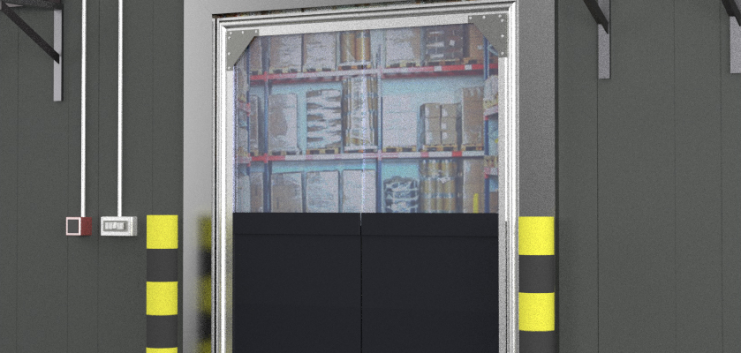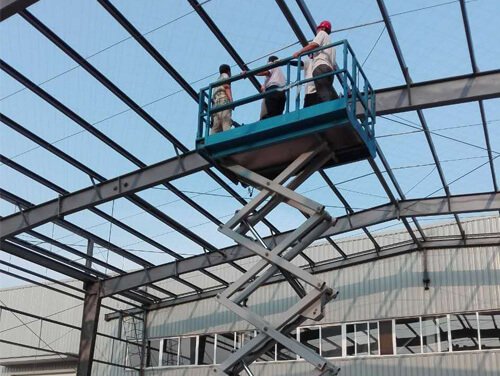Crash doors, also known as impact doors or safety doors, are heavy duty industrial doors designed to absorb impacts while still allowing entry and exit of vehicles or personnel. They are typically made from thick reinforced rubber or PVC and installed in locations where collisions may occasionally occur. Crash doors cushion impacts to minimise damage and injury.
Crash doors have become a necessity in busy industrial facilities to maintain accessibility while protecting people, buildings, products and equipment. They have a variety of valuable protective applications across multiple industries.
Applications in Warehousing and Logistics
Warehouses and distribution centres are one of the most common locations for utilising crash doors. Their frequent traffic and tight spaces inevitably lead to accidental impacts between forklifts, pallet jacks and the doorways themselves. Common applications include:
- Loading docks – Absorbs and cushions inevitable minor impacts from loading and unloading semi-trailer trucks. Protects building walls and doorway frames.
- Traffic doorways – Cushions contact between busy forklifts and aerial work platforms transiting interior doorways. Protects metal door frames from crushing.
- Cold storage entrances – Prevents damage to temperature-sensitive freezer and chiller rooms when impacted by material handling equipment.
- Warehouse endcaps – Defends vulnerable end-of-aisle storage racks and walls from common forklift collisions.
- Pedestrian exits – Offers protection for emergency and personnel doorways which still need to accommodate occasional vehicular impacts.
The ability to withstand and absorb repeated hard hits makes crash doors an ideal choice for high traffic and confined industrial spaces. They defend infrastructure while allowing efficient logistics flow.
Protecting Food Processing Areas
Food processing environments involve significant crossover between people and industrial equipment like forklifts and pallet jacks. Heavy rubber crash doors enable safe sharing of doorways:
- Kitchen exits – Allows quiet exit of cooking equipment from kitchens while cushioning contacts with the door frame edges.
- Food safety zones – Protects microbial-sensitive areas from potential contamination if impacted by material handling equipment.
- Cold storage access – Absorbs impacts to prevent temperature loss and damage to refrigeration rooms when collided with.
- Personnel access – Safe entry and exit for workers crossing paths with active forklifts and transports in processing areas.
- Equipment transfer – Permits delicate manoeuvring of cooking, packaging and waste removal machinery between zones while defending the doorway infrastructure itself.
Appropriate crash doors defend critical environments from accidental damage during everyday bustling crossover traffic.
Safeguarding Automotive Work Areas
Vehicle service facilities pose many risks of collisions occurring from moving cars and equipment. Industrial crash doors provide important protection:
- Paint booths – Prevents damage to sensitive spray booth walls and ventilation systems if bumped. Permits safe exit of painted vehicles.
- Lube bays – Cushions contact from lubrication equipment to maintain access while protecting machinery, walls and utilities.
- Wash tunnels – Withstands repetitive bumps from vehicle-carrying conveyors transitioning washed vehicles out without damaging the tunnel edges.
- Tire shops – Absorbs damage from tire machines, jacks and service vehicles moving in the space. Protects gas, air and electrical lines.
- Building supports – Cushions contact with interior columns, walls and critical equipment that needs to remain accessible to vehicles.
Proper crash doors maintain accessibility for vehicles while defending infrastructure from typical minor knocks and bumps occurring during service.
Shielding Institutional Entrances
Medical centres, schools, public buildings and other institutions all have internal traffic between people and service vehicles like laundry and food catering carts. Crash doors can prevent damage:
- Cafeterias – Allows safe passage of heavy food service trolleys and equipment without harming either the doorways or walls.
- Corridors – Cushions impacts from housekeeping and maintenance carts navigating hallways and thresholds.
- Loading bays – Protects structures from delivery impacts. Maintains clean access for waste removal and recycling.
- Laboratories – Prevents damage to critical equipment and workspace walls from cart and machinery traffic.
- Storage rooms – Absorbs hits in tight utility spaces from moving stock and supplies.
The heavy-duty construction and impact absorption of crash doors maintains facility integrity through constant equipment and vehicle movements.
How Crash Doors Work
Crash doors have robust protective features tailored for absorbing repeated hard hits without failing:
- Thick rubber – Typically over an inch thick. The rubber flexes and compresses to cushion direct impacts from vehicles. Rapidly returns to shape without tearing.
- Steel reinforcement – Sheets of steel inside the rubber add strength and prevent the door from splitting open on impact. Allows very hard hits.
- Bolt protection – Recessed bolts avoid damage during minor collisions. Keeps the door securely anchored to the frame.
- Stiffener bars – Horizontal and vertical bars hold the shape of large doors and spread impacts across the surface. Prevents localised rupturing.
- Perimeter bumpers – Thick bumper edges around the door further absorb side swipes and direct hits. Protects the door frame and surrounding walls.
Durable construction – Made from oil and fat resistant nitrile rubber to withstand intensive use and cleaning chemicals in industrial environments.
The combination of flexible impact cushioning, resilient materials and robust bolstered framing allows crash doors to reliably withstand years of unintended hits and impacts with minimal damage.
Selecting Appropriate Crash Doors
Choosing the right specification of crash door helps optimise cost effectiveness for the intended application:
- Traffic frequency – Doors in constant use by vehicles and equipment need maximum impact resistance. Minimal traffic needs only basic cushioning.
- Impact intensity – Forklifts, pallet jacks and heavily laden carts require greater impact absorption than light equipment and hand trucks.
- Size – Larger doors should have steel stiletto bars embedded to maintain shape and spread loads. Smaller doors can be fully rubber.
- Temperature – Doors for freezer and chiller rooms must remain flexible at low temperatures without becoming brittle.
- Environment – Food processing and corrosive areas need oil and chemical resistant materials. Cleanroom and static-sensitive areas may require special formulations.
- Closing force – High pressure differential environments need heavy duty seals and closing mechanisms to maintain closure following impacts.
Select doors that match the expected usage intensity and environment to optimise value. Avoid overspecifying for light duty usages.
Key Benefits of Using Crash Doors
Some key advantages to using crash doors include:
- Impact protection – Absorbs damage from collisions that would otherwise harm infrastructure, products, equipment and potentially workers.
- Preventing injuries – Cushioning effect greatly reduces risk of injuries from personnel being struck and pinned between vehicles and walls or racks.
- Maintains access – Allows efficient traffic flow for vehicles and equipment without having to stop and open/close doors. Improves productivity.
- Noise reduction – Dense rubber construction helps dampen audible impacts. Keeps facilities quieter.
- Avoiding costly repairs – minimises damage that would otherwise require expensive claims, repairs or replacement of structural walls, doors, equipment etc.
- Easy maintenance – Robust panel construction resists damage. Basic cleaning returns doors to like-new condition.
- Improving hygiene – Smooth surfaces without crevices simplify cleaning procedures. Important for food facilities.
Crash doors are an inexpensive item that can prevent extensive costs further down the line. Their protection extends beyond just the doors themselves.
Design and Customization Options
Though structurally robust, crash doors offer many choices for tailored performance and appearance:
- Colours – Available in a range of standard and custom colour finishes. Common colours are grey, yellow, red and blue. Custom match to corporate colours.
- Windows – Provide visibility through doors with protected shatter-resistant window panels if required. Popular for personnel doors.
- Logos – Allow decorative or corporate logos and branding. Can be embossed or printed onto door surfaces.
- Vision panels – Provide a narrow vertical window into cold storage spaces to monitor interior without fully opening doors. Reduces temperature loss.
- Ventilation ports – Perforated areas allow airflow through doors without needing to fully open them. Popular for cold and freezer spaces.
- Heated edges – Integrated heating cables in door edges prevent freezing shut in ultra cold environments like ice rinks.
- Access controls – Integrate card, code or push button access controls into frames for managing authorised entry if required.
Doors can be fully customised to match site requirements and aesthetics.
Choosing Appropriate Door Hardware
Hardware selection impacts overall functionality:
- Hinges – Wide butt or piano style hinges allow necessary flexibility during impacts. Geared hinges control closing speed.
- Lock types – Crash-proof tongue or anchor locks survive minor hits without failure. Match security level to door usage – padlocks often sufficient.
- Closing mechanisms – Use spring hinges, hydraulic closers or automatic operators to ensure positive closure after impacts. Critical for temperature controlled rooms or high pressure differences. Avoid lightweight surface-mounted closers prone to damage.
- Seals – Thick rubber seals around all edges maintain environmental separation despite flexing impacts. Heated or hygienic seals available.
- Activation controls – Hands-free motion detectors, pull cords and air switches enable easy use while approaching with carts and equipment.
Appropriate hardware ensures doors function reliably despite regular unintended impacts in demanding industrial settings.
Maintenance Requirements
Basic maintenance helps maximise service life:
- Inspect for damage after major collisions and replace panels or sections as needed. Catch minor issues before they expand.
- Tighten any loosened hardware. Check anchors and brackets remain secure to frame.
- Clean regularly with commercial degreasing detergents and pressure spraying. Avoid buildup of oils, chemicals and grime.
- Ensure the door operates smoothly and fully closes/seals following minor collisions. Adjust alignment or add electro-hydraulic closers if needed.
- Confirm heated edges on freezer doors activate properly to avoid becoming stuck. Replace damaged heat tapes.
- Lubricate hinges and pins with silicone or lithium grease every 6 months.
Well maintained doors absorb impacts for years with only minimal upkeep needed. Doors damaged beyond repair can have panels replaced individually.
The Bottom Line
Crash doors provide valuable protection from inevitable minor impacts between equipment, vehicles, and infrastructure in bustling industrial facilities. Their durable cushioning construction preserves accessibility while avoiding business disruptions and expensive structural damage. Appropriately designed crash doors meshed with daily operations help maximise productivity and safety. Despite regular unintended hits, well-maintained crash doors maintain a like-new appearance for years. Their relatively low one-time cost avoids far greater expenses over the long term.
For frequent access points prone to collisions, crash doors are an ideal solution. They absorb impacts smoothly while letting business roll steadily forward.











